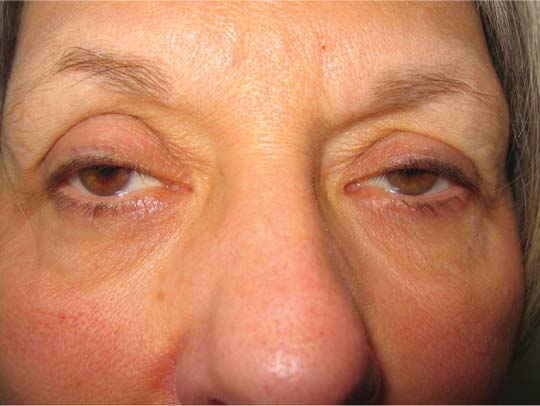87 A 55-year-old woman presents with “heavy eyes” and occasional frontal headaches. Her friends often tell her she looks sleepy and they cannot see her eyes because they look “droopy.” She must manually lift her eyebrows to see better; another surgeon has offered her an endoscopic brow lift. She is seeking another opinion. Further questioning reveals that her headaches occur toward the end of the day, especially after prolonged reading, but review of systems is otherwise normal. She has worn contact lenses for longer than 20 years and has not had eye surgery. Examination shows a healthy-appearing woman with bilateral upper blepharoptosis and the top half of her pupils are covered by the eyelid margin. Levator function is normal, and there is no variability of the eyelid height. She has mild temporal brow ptosis. (Fig. 87.1). Fig. 87.1 Preoperative photo of the patient. Individuals presenting with “heavy” or “droopy” eyelids need to be fully evaluated to accurately determine the cause for the eyelid abnormality. Simple eyelid tightening or brow-lifting procedures may not always be indicated, and multiple systemic conditions can cause eyelid malpositions. Common terms used to describe the eyelid are listed below to clarify this confusing terminology: Several systemic conditions can cause eyelid abnormalities:
Eyelid Ptosis Rejuvenation
History
Differential Diagnosis—Key Points
 Blepharochalasis refers to any excess tissues of the eyelids and is a broad term. However, this should be reserved for a rare variant of angioneurotic edema, which presents as recurrent eyelid swelling in young women.
Blepharochalasis refers to any excess tissues of the eyelids and is a broad term. However, this should be reserved for a rare variant of angioneurotic edema, which presents as recurrent eyelid swelling in young women.
 Dermatochalasis is the most appropriate term used to describe excess upper-eyelid skin that occurs with age.
Dermatochalasis is the most appropriate term used to describe excess upper-eyelid skin that occurs with age.
 Blepharoptosis, or ptosis of the upper eyelid, describes the abnormal downward positioning of the eyelid. When the eyelid margin hangs over the pupil, this constricts the superior visual field.
Blepharoptosis, or ptosis of the upper eyelid, describes the abnormal downward positioning of the eyelid. When the eyelid margin hangs over the pupil, this constricts the superior visual field.
 Pseudoptosis refers to the false appearance of blepharoptosis, in which the excess upper lid and brow tissues hang over the eyelid margin.
Pseudoptosis refers to the false appearance of blepharoptosis, in which the excess upper lid and brow tissues hang over the eyelid margin.
 Lid retraction occurs when the eyelid is open too far and the sclera can be seen between the cornea and the eyelid margin. This can result in inability to close the eye (lagophthalmo s) and exposure keratopathy.
Lid retraction occurs when the eyelid is open too far and the sclera can be seen between the cornea and the eyelid margin. This can result in inability to close the eye (lagophthalmo s) and exposure keratopathy.
 Hyperthyroidism in Graves disease can cause upper and lower eyelid retraction and prop-tosis of the globes. Hypothyroidism causes periorbital edema and lower eyelid bags, referred to as festoons.
Hyperthyroidism in Graves disease can cause upper and lower eyelid retraction and prop-tosis of the globes. Hypothyroidism causes periorbital edema and lower eyelid bags, referred to as festoons.
 Allergies can cause intermittent periorbital edema and erythema as well as dermatitis of the eyelids.
Allergies can cause intermittent periorbital edema and erythema as well as dermatitis of the eyelids.
Stay updated, free articles. Join our Telegram channel

Full access? Get Clinical Tree



